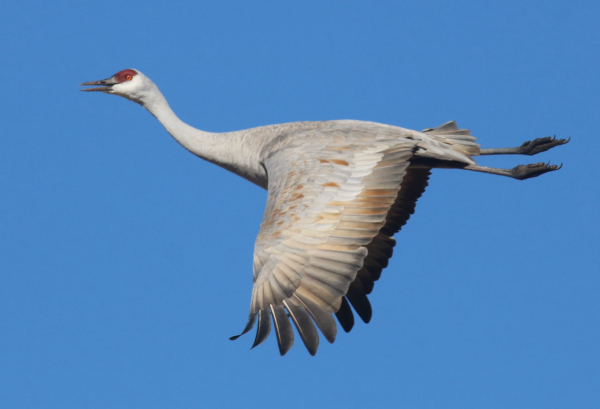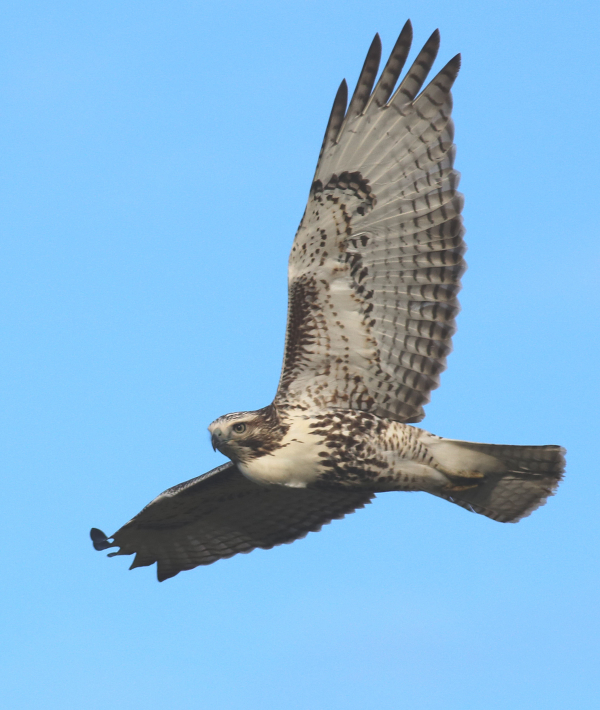
A short drive along the road where this favorite photo of a Lesser Sandhill Crane was taken 2 springs ago led to a surprising sighting of a rare bird.

Although the Common Crane was quite a distance away, it provided a standout sighting among the Sandhill Cranes that included Lesser and Greater subspecies.

Common Cranes nest across northern Europe and Asia; this off-course crane probably flew down the wrong side of the Pacific, possibly following Sandhill Cranes from Siberia.

Red-tailed Hawks provided interesting focal points along the driving transect across the Great Plains.
|
In the northland – North Dakota, that is – there were a few holdovers from earlier surges of the earliest migrants as I began my reverse migration south. A few Cackling Geese mixed with Canadas, a male Northern Harrier, an American Crow, and a small flock of Snow Geese. But South Dakota definitely had a migration event going on – along with Nebraska – and there was more excitement the farther south I drove.
A few miles into South Dakota, flocks of geese began filling the sky – 5 species of geese – Snows, Ross’s, White-fronts, Cackling, and Canada Geese. They continued to Aberdeen with a brief break until about 20 miles north of Huron, where big flocks continued to fill the sky to the border of Nebraska – the Missouri River. Just north of the river a flock of about 250 American Crows was actively feeding in a harvested ag field, and another 250 migrating on the Nebraska side with another 100 or so a few miles farther south. Along the Missouri River woodlands I spied 2 flocks of Wild Turkeys numbering 12 and about 25.
In Nebraska, numbers of Red-tailed Hawks noticeably increased, and south of the Niobrara River I spotted a distant Golden Eagle and 3 Rough-legged Hawks along a 5 mile stretch of highway.
Nearing peak spring migration numbers, the Platte River Valley was filled with Sandhill Cranes – hundreds of thousands – with crane music and the sights and sounds of the most abundant cranes in the world. A point of interest is that I was on a mission to photograph the rarest cranes in the world – Whooping Cranes – in the coastal marshes of Aransas National Wildlife Refuge in Texas. Wanting to spend a little time among the Sandhills, I visited some favorite areas east of Kearney, Nebraska for an hour or so. The light was terrible that cloudy Thursday morning, but I thought I’d try a few photos, especially because many Sandhills were actively dancing.
Rare UnCommon Crane!
At the end of the road to the historic site of Lowell, I stopped to reminisce a moment about a favorite flight photo I took of a Lesser Sandhill Crane, the smallest subspecies that nests in the Arctic reaches of Canada, Alaska, and far eastern Siberia. I focused my camera lens on a distant flock of Sandhills to the west and immediately noticed a bit of chasing activity that brought my attention to a Common Crane! It was on the far side of the flock, barely visible; but it was on the move through the flock, being chased as it advanced. I took a few documentary photos and then it hit me that this was a major find – a rare Old World species that nests in northern Europe and Asia and winters in southern Asia and northern and east Africa. It was really my biggest rare bird find to date!
This Common Crane probably flew down the wrong side of the Pacific, as rare birds from Asia regularly do, possibly following Sandhill Cranes from Siberia; albeit more accommodating Sandhills than the ones before me that obviously did not want this outsider in their midst. The off-course crane was eventually pushed to the north end of the flock and soon took flight, heading northwest in the direction of Audubon’s Rowe Sanctuary, which is only about 2 miles away. The Common Crane allowed me to do something I probably won’t be able to repeat again – seeing and photographing 3 different crane species in 3 days in North America!
Well, how was I going to beat that at the Platte? It was time to hit the road again, but during my drive east for about 50 miles, before turning south again, there were flocks of thousands of Sandhill Cranes in harvested corn fields, open grasslands, shallow wetlands, and across the sky. Like the goose action in the Dakotas, the spring Sandhill activities along the Platte River in central Nebraska is a remarkable natural event that must be experienced to fully appreciate.
Halfway There
As I drove toward Kansas numbers of Red-tailed Hawks continued to increase, and Kansas and Oklahoma showed how important these states are to the wintering hawks. It’s always fun for me to see the broad variation in plumage colors among this common species, and it seemed that every option was represented along the way from a number of dark morph Harlan’s Red-tails to a very light-colored Krider’s Red-tail and every imaginable shade in between. Most of the hawks had brown belly bands, indicating to me that they were among the populations that nest in the northern forests of Canada, although there were many Red-tails with unmarked beige undersides, which tend to be indicative of populations that nest in the Great Plains. Some local Red-tails were already nesting in Kansas, with more incubating on nests in Oklahoma.
American Kestrels became more and more common along the way, and the first 2 Turkey Vultures appeared along a ridge south of Salina, Kansas with a migrating flock of about 20 in northern Oklahoma. Flocks of ducks were much more evident across Kansas, including a good mix of dabbling and diving species. The first small flocks of Double-crested Cormorants were present in southern Kansas as was the first Great Blue Heron of the drive. Purple Martins were at a martin apartment on a lakeshore north of Wichita, and the first shorebirds showed up in northern Oklahoma – 2 Greater Yellowlegs.
Texas is a darn big state, and it took all of Friday to cross it with my initial goal almost in sight – the Gulf Coast. Hawk numbers dropped off, but American Kestrels were more common across the state. The first Black Vultures led to more scattered across the state, and Turkey Vultures were especially abundant, probably constituting resident or wintering birds, but also indicative of migrating vultures coming up from Latin America. Tree Swallows widespread and probably constituted some migratory flights; and I noticed one Barn Swallow.
Finally, there I was, skirting the coast on the way to Aransas Refuge. There it was like a different avian world, with Anhingas, Great Egrets and Snowys, White Ibis, Long-billed Curlews, Willets, Laughing Gulls, Caracaras, Loggerhead Shrikes, and even Yellow-rumped Warblers. Whoo-eee! I made it! There was the ocean expanse to the south, and now it was time to enjoy the new birding opportunities that this area and the associated coastal region offers – from there to the Rio Grande Valley, then following the Texas coast back north and east all the way to Louisiana and around the Florida Gulf Coast!
As I continue my birding trip, I’ll keep you posted week by week; although you can follow more of my birding week and see new Texas bird photos in this issue in the Editor Afield article and the Bird Photography feature. As spring migration progresses, I hope you enjoy some interesting sightings and insights, and encourage you to take a drive – a birding drive – a few miles out of town, down the road, and enjoy the birds you see along the way.
Article and photos by Paul Konrad
Share your birding experiences and photos at editorstbw2@gmail.com